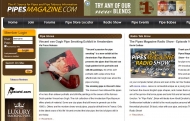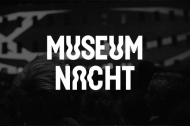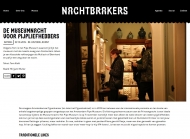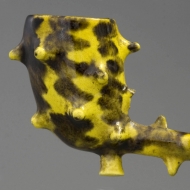Amsterdam Pipe Museum in American Pipes Magazine
24 October 2015

The news about the Vincent van Gogh exhibition in Amsterdam spreads quite far. We saw it on the front page of the website PipesMagazine.com, probably the most important online magazine for pipe smokers in the world. See for the complete article online: http://pipesmagazine.com/blog/pipe-shows/vincent-van-gogh-pipe-smoking-exhibit-in-amsterdam/
PermalinkNight owls
20 October 2015

According to Tom Kieft, the Amsterdam Pipe Museum is probably the museum with the most swag in Amsterdam. Imagine yourself as a classic womanizer like Harry Mulisch or Prince Bernhard and make your way through the night.
The Museum Night for pipe lovers
The former Amsterdam Pipes Room (and later the Pipes Cabinet) was renamed the Amsterdam Pipe Museum in 2013 for the purpose of international promotion and at the expense of a number of easily accessible jokes. This small canal house museum on the Prinsengracht is an ideal stopover on Museum Night. On 7 November the Amsterdam Pipe Museum is more than just the wet dream of every pipe lover; you can enjoy delicious local sausages here and quench your thirst with bottled German beer . This beer is not your average Oettinger pilsner, but a smoked beer. And no, smoked beer is not a bottle filled with cigarette butts, but a beer made from smoked hops. I can tell you: fucking nice and especially for our "more-hop-is-hip IPA lovers", it is a must to come and taste this hip hop beer.
Traditional likes
Even if smoked beer, sausages or the beautiful building are not convincing, the collection and the accompanying explanations give sufficient reason to visit this site on November 7. Throughout the evening, museum staff are ready to tell you all about the pipe collection of the Amsterdam Pipe Museum. This collection ranges from 500 BC to the present, from the first South American tobacco pipes to nineteenth-century European pipes, from Turkish shishas to Chinese opium pipes. You will learn that pipes are more than just pleasure instruments. There are French pipes in the museum with pictures of favourite writers, a kind of traditional "like" to inform friends and strangers about your literary preferences. With other pipes in the museum, the shape of the pipe has an even more important public function. For example, the gigantic chief pipes from Cameroon are, in addition to smoking equipment, objects to express power: the owner of the largest pipe has the most power. So even with pipes: size does matter!
Characteristic pipes
The museum curator will talk twice in the evening about well-known twentieth-century pipe smokers such as writer Harry Mulisch and Prince Bernhard, their favourite pipes and how the specific pipes of these gentlemen match their character. If you are inspired by all this beauty and you want to acquire a pipe for yourself, you are at the right place, because in addition to a pipe museum, this building also houses a well-equipped pipe shop. On the ground floor of the Amsterdam Pipe Museum you can buy a pipe, with which you can parade with swagger to the next museum.
An article in a hipster blog
7 October 2015

A group of young culture aficionados in Amsterdam is writing a blog on theater, film and museums that they visit. In November they will have an active role in the famous Amsterdam Museum Night. Their blog is called Nachtbrakers and features a wide variety of cultural events. In September we had the pleasure of a visit by Tom, one of these bloggers. He wrote a dazzling and inspiring article on the Amsterdam Pipe Museum. We are curious to experience how his readers will react!
PermalinkColourful Belgian pipes
5 October 2015

From our museum collection we show a dozen of pipes with a special finish in colourful marble glaze. All examples are press moulded clay pipes with transparent glaze. A lot of speculation about these pipes is given. Writers thought that it is Whieldon ware from England and should date from the eighteenth century. The finish is however characteristic for two workshops in Belgium: Félix Wingender from Chokier and Jean-Jacques Knoedgen in Brée. This technique of glazing was their specialty. The pipes became much more attractive, although with that finish also the p[rice went up considerably. After the first baking the pipes were glazed and thereafter placed on a stand went into the kiln for a second time. Then it was important that the temperature was well looked after, when to hot, the glaze dripped of the pipe, when cooling down to fast the shine would disappear.
Permalink